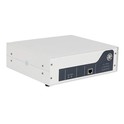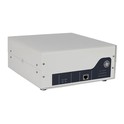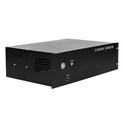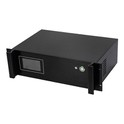The application of ultrasonic transducers is very extensive. According to the industry of application, they are divided into industry, agriculture, transportation, life, medical treatment and military. According to the functions realized, they are divided into ultrasonic processing, ultrasonic cleaning, ultrasonic detection, detection, monitoring, telemetry, remote control, etc.; according to the working environment, they are divided into liquid, gas, organism, etc.; according to the properties, they are divided into power ultrasound, detection ultrasound, ultrasonic imaging, etc.
Piezoelectric ceramic transformer
The piezoelectric ceramic transformer uses the piezoelectric effect of the polarized piezoelectric body to achieve voltage output. Its input part is driven by a sinusoidal voltage signal, which is vibrated by the inverse piezoelectric effect. The vibration wave is mechanically coupled to the output part through the input and output parts. The output part then generates charge through the positive piezoelectric effect, realizing the two conversions of electrical energy-mechanical energy-electrical energy of the piezoelectric body, and obtaining the highest output voltage at the resonant frequency of the piezoelectric transformer. Compared with electromagnetic transformers, this has the advantages of small size, light weight, high power density, high efficiency, resistance to breakdown, high temperature resistance, no fear of burning, no electromagnetic interference and electromagnetic noise, simple structure, easy to make, easy to mass produce, and ideal replacement components for electromagnetic transformers in some fields. Such transformers are used in switching converters, laptops, neon lamp drivers, etc.
Ultrasonic motor
Ultrasonic motor uses the stator as a transducer, uses the inverse piezoelectric effect of piezoelectric crystals to make the motor stator vibrate at ultrasonic frequency, and then relies on the friction between the stator and the rotor to transfer energy and drive the rotor to rotate. Ultrasonic motors are small in size, large in torque, high in resolution, simple in structure, directly driven, without brake mechanism, and without bearing mechanism. These advantages are beneficial to the miniaturization of the device. Ultrasonic motors are widely used in optical instruments, lasers, semiconductor microelectronics processes, precision machinery and instruments, robots, medicine and bioengineering.
Ultrasonic cleaning
The mechanism of ultrasonic cleaning is to use the physical effects of cavitation, radiation pressure, and acoustic flow when ultrasonic waves propagate in the cleaning liquid to mechanically peel off the dirt on the cleaning parts, and at the same time promote the chemical reaction between the cleaning liquid and the dirt to achieve the purpose of cleaning the objects. The frequency used by the ultrasonic cleaning machine can be selected from 10 to 500 kHz according to the size and purpose of the cleaning object, and is generally 20 to 50 kHz. With the increase of the frequency of the ultrasonic transducer, Langevin vibrators, longitudinal vibrators, thickness vibrators, etc. can be used. In terms of miniaturization, radial vibration and bending vibration of disc vibrators are also used. Ultrasonic cleaning has been increasingly widely used in various industries such as industry, agriculture, household equipment, electronics, automobiles, rubber, printing, aircraft, food, hospitals, and medical research.
Ultrasonic welding
Ultrasonic welding has two categories: ultrasonic metal welding and ultrasonic plastic welding. Among them, ultrasonic plastic welding technology has been widely used. It uses the ultrasonic vibration generated by the transducer to transmit the ultrasonic vibration energy to the welding area through the upper weldment. Since the acoustic resistance of the welding area, i.e. the junction of the two welded parts, is large, local high temperature will be generated to melt the plastic, and the welding work will be completed under the action of contact pressure. Ultrasonic plastic welding can facilitate the welding of parts that cannot be welded by other welding methods. In addition, it also saves the expensive mold costs of plastic products, shortens the processing time, improves production efficiency, and has the characteristics of economy, speed and reliability.
Ultrasonic machining
Adding fine abrasives to the workpiece with a certain static pressure along with the ultrasonic machining tool can produce the same shape as the tool. During machining, the transducer needs to generate an amplitude of 15 to 40 microns at a frequency of 15 to 40 kHz. The ultrasonic tool makes the abrasive on the surface of the workpiece impact continuously with considerable impact force, destroying the ultrasonic radiation part, breaking the material and achieving the purpose of removing the material. Ultrasonic machining is mainly used in the processing of brittle and hard materials such as gems, jade, marble, agate, and cemented carbide, as well as the processing of special-shaped holes and fine deep holes. In addition, when adding ultrasonic transducer vibration to ordinary cutting tools, it can also play a role in improving accuracy and efficiency.
Ultrasonic weight loss
Using the cavitation effect and micromechanical vibration of the ultrasonic transducer, the excess fat cells under the human epidermis are broken, emulsified and excreted from the body to achieve the purpose of weight loss and body shaping. This is a new technology developed internationally in the 1990s. Zocchi in Italy first used ultrasonic fat removal on the bed and achieved success, creating a precedent for plastic surgery and beauty. Ultrasonic fat removal technology has developed rapidly at home and abroad.
Ultrasonic breeding
Irradiating plant seeds with ultrasonic waves of appropriate frequency and intensity can increase the germination rate of seeds, reduce the mold rate, promote seed growth, and increase the growth rate of plants. According to information, ultrasound can increase the growth rate of some plant seeds by 2 to 3 times.
Electronic sphygmomanometer
Use ultrasonic transducer to receive blood vessel pressure. When the airbag is pressurized and pressurized, the ultrasonic transducer cannot sense blood vessel pressure because the external pressure is higher than the vasodilation pressure. When the airbag is gradually deflated, the pressure of the ultrasonic transducer on the blood vessel decreases to a certain value, and the pressure of the two reaches a balance. At this time, the ultrasonic transducer can sense the blood vessel pressure, which is the systolic pressure of the heart. The amplifier sends an indication signal to give the blood pressure value. Electronic sphygmomanometer can reduce the labor intensity of medical staff because the stethoscope is eliminated.
Telemetry and remote control
In harsh environments such as toxic and radioactive environments, people cannot approach work and need to control remotely. Televisions, electric fans, lights and other electrical switches need to be remotely controlled. They can be equipped with ultrasonic transducers. Ultrasonic waves are transmitted remotely and received by the receiving transducer installed on the control system to be controlled. The sound signal is converted into an electrical signal to make the switch operate.
Traffic monitoring
In modern transportation, it is very necessary to automatically monitor the passage and count of vehicles in order to grasp the operation of vehicles. For example, if a traffic monitoring station installs a transceiver and its auxiliary equipment, when a vehicle passes, a sound pulse will be returned, and the number of vehicles traveling per day can be obtained by counting and accumulating. Installing a transceiver at the rear of the car can prevent reverse collision accidents. Installing a receiving piezoelectric ultrasonic transducer on the road can also monitor the noise index.
Distance measurement
The ultrasonic distance measuring device is also called a sound ruler. It measures the pulse time interval through a transceiver. The sound ruler can measure the distance within 10m with an accuracy of a few thousandths.
Leak detection and gas detection
For pressure systems, at the leak, the jet noise is caused by the internal and external pressure difference of the pressure vessel. This noise spectrum is extremely wide. For non-pressure systems, an ultrasonic source can be placed in the closed system and then received from the outside of the closed system. Generally, the signal amplitude measured when there is no leakage is very small or there is no signal, and the signal amplitude tends to increase suddenly at the leak. Gas flow detection is also one of the important means in chemical industry. There are currently many amplifications for flow detection, such as float flowmeters. But the main advantage of using ultrasonic transducers is that they do not hinder the flow of fluids.
Information Collection
Intelligent robots need to realize functions such as free walking in space and identifying objects. They need to use ultrasonic transducers not only for distance measurement and blind guidance, but also for imaging and recognition. Therefore, a small ultrasonic transducer array is needed to realize multiple functions. This aspect will become an important research topic, attracting many scientists to strive for it.
May 11, 2024
Application Of Ultrasonic Transducers
Send Inquiry






